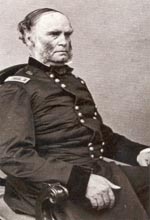Samuel R. Curtis
Born in Champlain, New York, in 1805, Samuel Curtis moved to Ohio with his family when he was a young child, and was raised in that state. He graduated from West Point in 1831, but left the army after only about a year, opting for a career in law and politics.
He had become Captain of the Ohio Volunteer Militia in 1833 while continuing to practice law, and was later promoted to Lieutenant Colonel, then Colonel.
He became Adjutant General of Ohio, charged with organizing the state’s quota of volunteers for the Mexican War. He served in that war as Colonel of the 2nd Ohio Regiment, and was Commandant of Camargo, a large military depot, and is credited with holding it against General Urrea, then pursuing the enemy through the mountains to Ramos, Mexico, opening a communications line for General Taylor.
At the end of the Mexican War, he served on General Wool’s staff, then as Governor of Saltillo, Mexico from 1847 to 1848, then was involved in the railroad business before settling back as a lawyer in Ohio.
He was elected to Congress as a Republican, serving two terms and part of a third, from 1857 to 1861, to become Colonel of the 2nd Iowa Volunteer Infantry after the outbreak of the American Civil War.
In May of that year, he was appointed Brig. General, taking charge of a military training camp in St. Louis in August and September of 1861.
He commanded the Southwest District of Missouri from December 1861 till February 1862, when he was put in charge of the Army of the Southwest until August of 1862.
At Pea Ridge, Arkansas, he gained a decisive victory against the Confederate armies of Generals Price and McCulloch in early March of 1862, after which he was promoted to Major General.
From July 14 to August 29, he occupied Helena, Arkansas, having marched more than a thousand miles through wilderness and swamp.
 During a one month leave of absence, beginning in late August of 1862, he served as President of the Pacific Railroad Convention in Chicago During a one month leave of absence, beginning in late August of 1862, he served as President of the Pacific Railroad Convention in Chicago
He commanded the Department of the Missouri from September 1862 to May 1863, and of the Department of Kansas from January 1864 to February 1865.
He was in command at Fort Leavenworth during the Price raid of October 1864, assisting in the defeat and pursuit of General Price’s army.
He commanded the Army of the Northwest from February 1865 until the end of the war.
He was appointed Indian Commissioner, and charged with negotiating treaties with various tribes from August to November of 1865.
He died in 1866.
|

